Gather ingredients. These are common items that would be found in any Vietnamese kitchen!
- Pork (thịt heo): Virtually any cut is possible. Thịt ba rội (pork belly) is a favorite in Vietnamese cuisine. Sườn (short ribs) are another delicious crowd-pleaser. We have opted for loin for the leanest option.
- Shallots (hành tím)
- Ginger (gừng)
- Garlic (tỏi)
- Chili peppers (ớt): We used a combination of cayenne and Thai chili peppers from our very own balcony garden!
- Salt (muối)
- Pepper (tiêu): We will use black and white peppercorns straight from Vietnam, given to us by Bác Mai. These will be freshly ground in a pepper mill from Ngoại.
- Sugar (đường): Kathy May’s mom (Mẹ) frequently used either rock sugar or granulated sugar or a combination of the two. We will use the latter which we have quickly on-hand.
- Fish sauce (nước mắm): Possibly the most quintessential element of Vietnamese cuisine.
- Dark soy sauce (nước tương): This is not a typical ingredient of thịt kho, but it is a secret weapon that Mẹ used! Dark nước tương is less salty but more colorful than the light version. This will help to achieve the perfect aesthetic of our thịt kho.
- Oil (dầu)
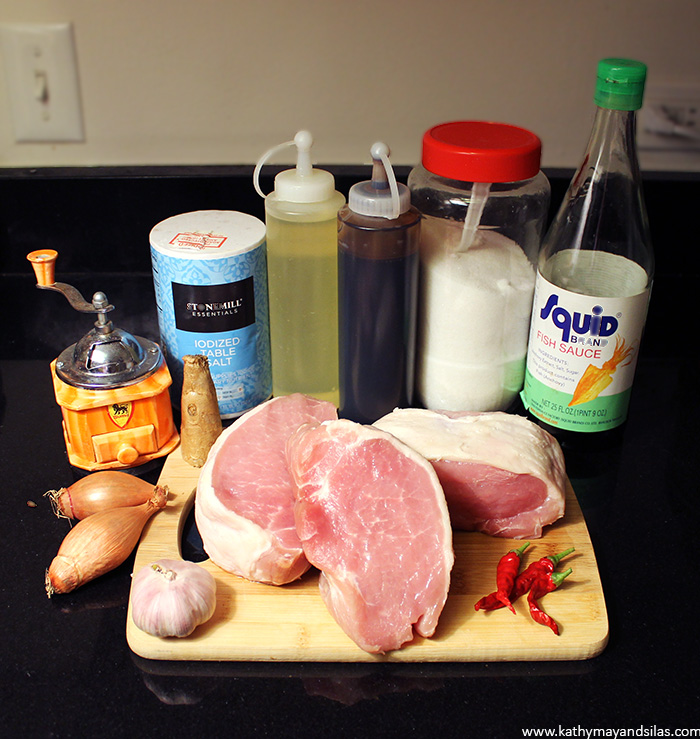
First, clean and cut the meat. Bring a large pot to boil and drop your uncut piece of pork into it for just a minute or two. This cleans the meat, preventing the proteinaceous build-up that can happen during cooking, and also remove any porky smells, just leaving the pure flavor of the meat. Chop the pork into chunks (slices would also be acceptable for similar taste but different aesthetic). Dice ginger, shallots, garlic, and chili in preparation.
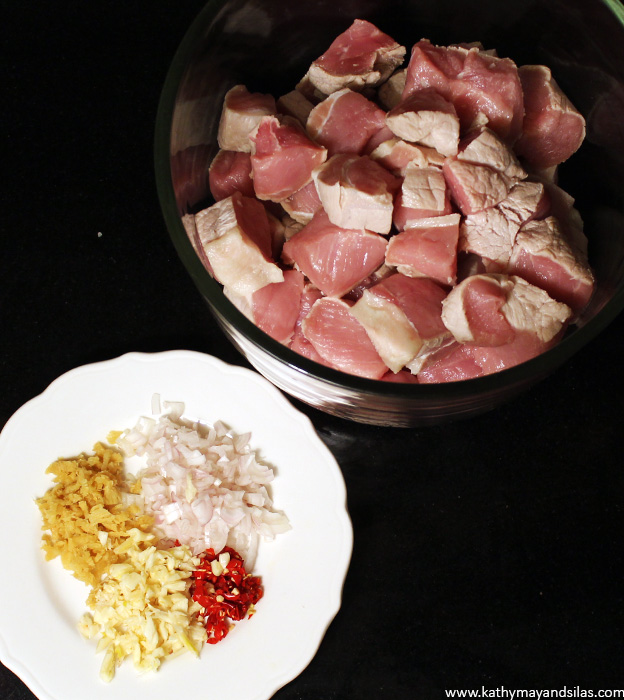
Marinate the meat. Marinate the pork for at least 30 minutes (the longer the better) with the diced aromatics. Also add salt, pepper (lots of it), sugar, and fish sauce to taste. Remember that thịt kho tiêu tends to be more salty, and it will be served with plenty of rice, so we will be generous.
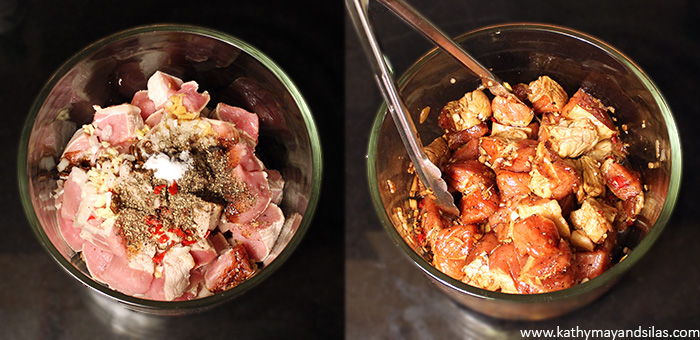
Brown the meat. In a pot large or pan, add a couple tablespoons of cooking oil. Saute garlic until it becomes aromatic. Add the pork and brown the outside. This step helps to seal in the juices; the meat need not be fully cooked.

Make the nước màu (caramelization). While the pork is browning, we will prepare our caramelized sugar, which is the main step of making thịt kho. Note that many home cooks will recommend caramelizing the sugar first and then adding the meat in it to braise (that’s the way Kathy May’s mom does it). However, we as more novice cooks opt to do caramelize sugar and add it separately, for the reason that sugar on heat can be difficult to control. Furthermore, caramel may be made without water or oil, but the addition of these also make the process easier. We will add a couple tablespoons of cooking oil and a few tablespoons of sugar on a warm – not hot – pan. Turn on the heat and gently melt, stirring the entire time. Do not take our eyes off this sugar! It burns easily and rapidly!
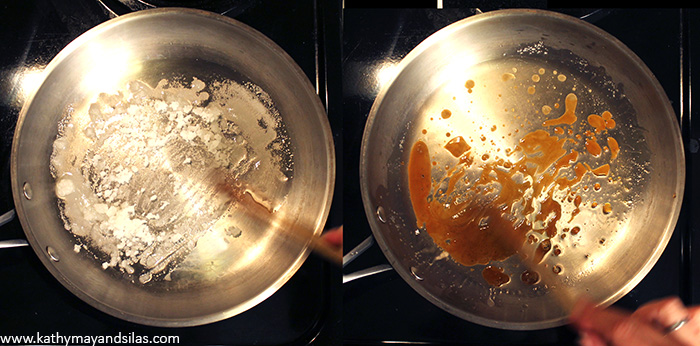
Add the caramel to the meat. Once the sugar browns nicely, take it off the heat (still stirring constantly) and it will continue darkening over seconds. If your sugar is burned or overcooked, throw it away and start over! If your sugar is not brown enough, it will be insufficient to color your meat. Add the caramel directly to the pot of meat.
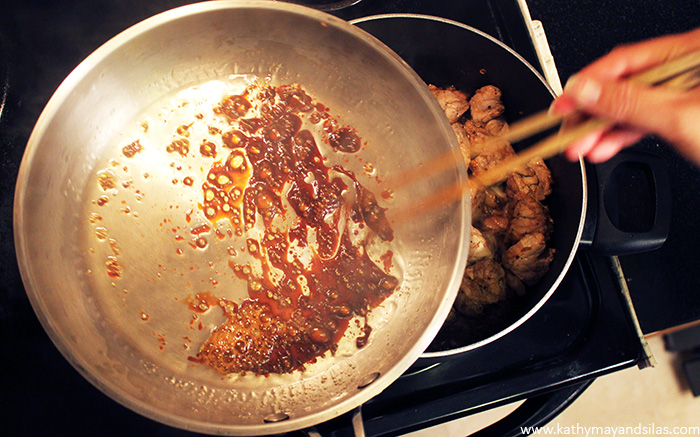
Braise the meat. Continue cooking the meat, stirring occasionally to distribute the sauce. Liquid will come from the pork; there is no need to add more water or coconut juice as in other versions of thịt kho.

Achieve a delicious brown color. As the liquid boils away, the pork will become a scrumptious dark reddish brown. If the color is not brown or deep enough, add a little dark soy sauce (that’s the secret shared by Kathy May’s mom!).
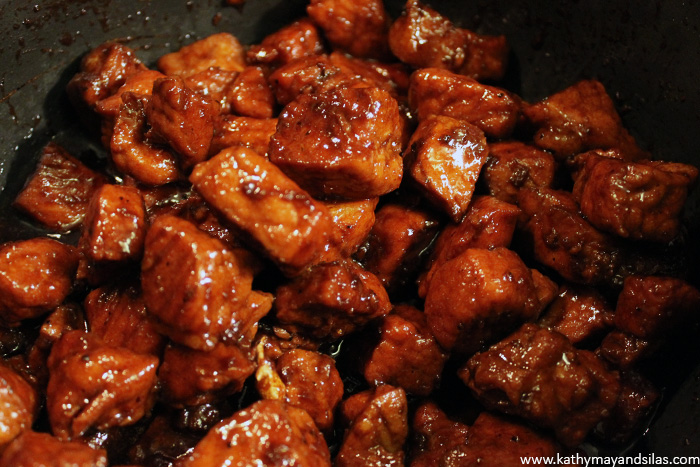
Bon appétit. Our thịt kho tiêu has a saltiness that is distinctively Vietnamese from the fish sauce marinade; also sweetness from our labored-upon nước màu (caramelization) that provides a depth of flavor; and finally a pleasant bite from the fresh pepper without being outright spicy! A generous bowl of steaming white rice is an essential accompaniment. We will also enjoy it with a vegetable side.
Please share with us your versions of thịt kho tiêu by dropping a note in the Comments section below. Do you have tips and tricks to share? We would love to learn from you and experiment from your recipes!
Until next time,
Kathy May and Silas
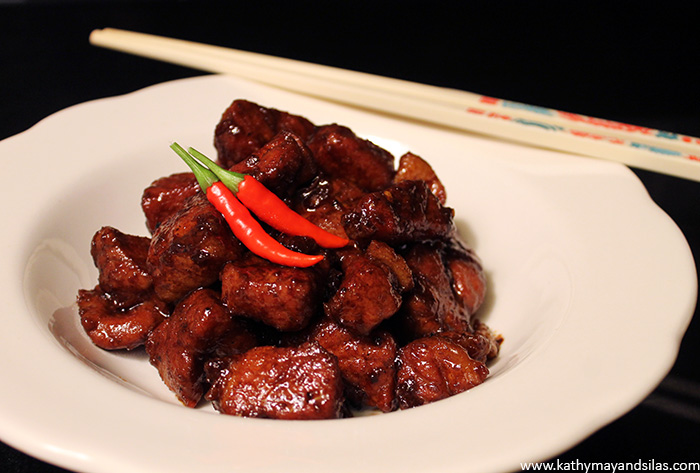
Bánh giầy (pronounced “ban yay,” sometimes incorrectly written as “bánh dầy” or even “bánh dày”) is a yummy and simple Việt snack. It is a glutinous rice patty steamed on banana leaf, usually served sandwiched with giò lựa (also known as chả lựa, which my family calls “Vietnamese ham,” probably better characterized as “Việt sausage”). My mom (Mẹ) used to make a batch or two of bánh giầy and a log of giò, stick them in the fridge, and we would take them out to microwave as a snack. When we traveled through Vietnam, my grandma (Ngoại), my aunt (Má Bé), and the rest of my family brought these along for the road trip.
Nguyên liệu (Ingredients): This recipe should yield 16 patties (or 8 bánh giầy giò sandwiches).
- 1 cup bột nếp (glutinous rice flour)
- 2 tbsp bột tẻ tinh khiệt (regular rice flour)
- 1-3/4 cup nước lạnh (water)
- 2 tbsp dầu nấu (vegetable oil)
- 1/2 tsp muối (salt)
- Lá chuối (banana leaves)
- Giò (Vietnamese ham)
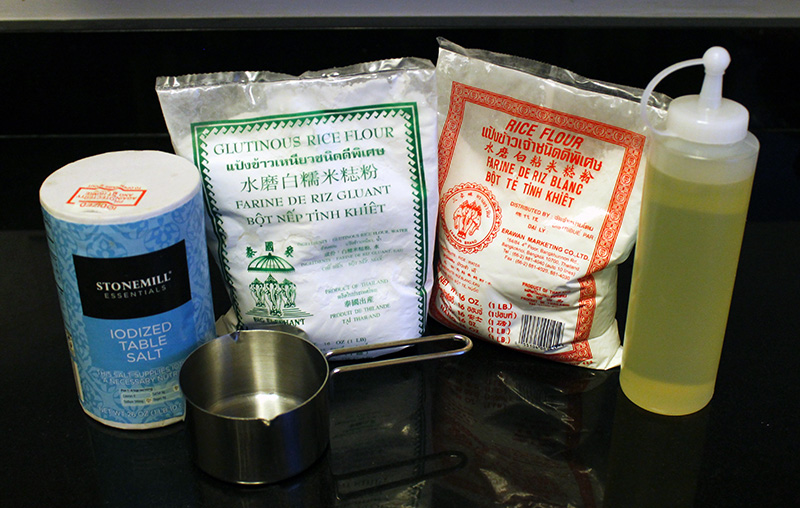
Combine the glutinous rice flour, rice flour, water, vegetable oil, and salt in a mixing bowl. Mix by hand or machine until all dry ingredients are incorporated. Your mixture will appear crumbly but should become a smooth consistency when squeezed into a ball. 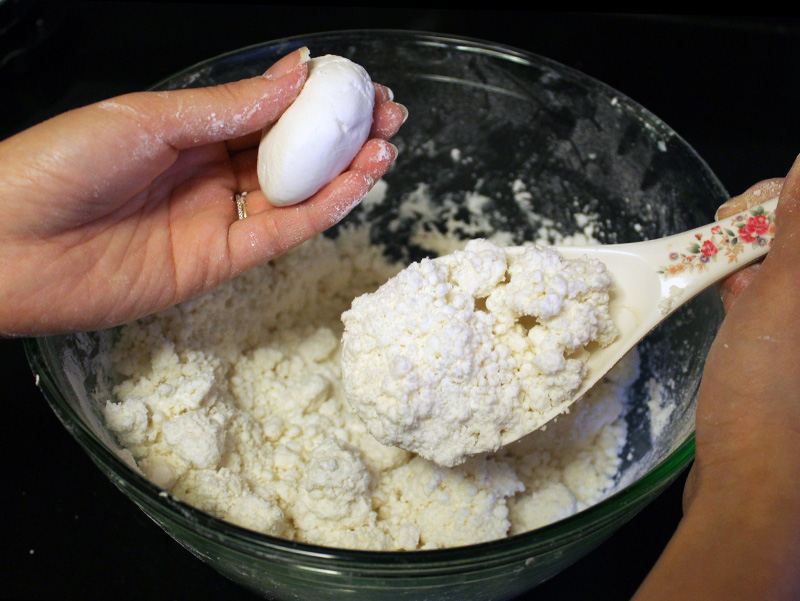
Knead the crumbly mixture into a dough. Add additional water, a tablespoon at a time, if needed.
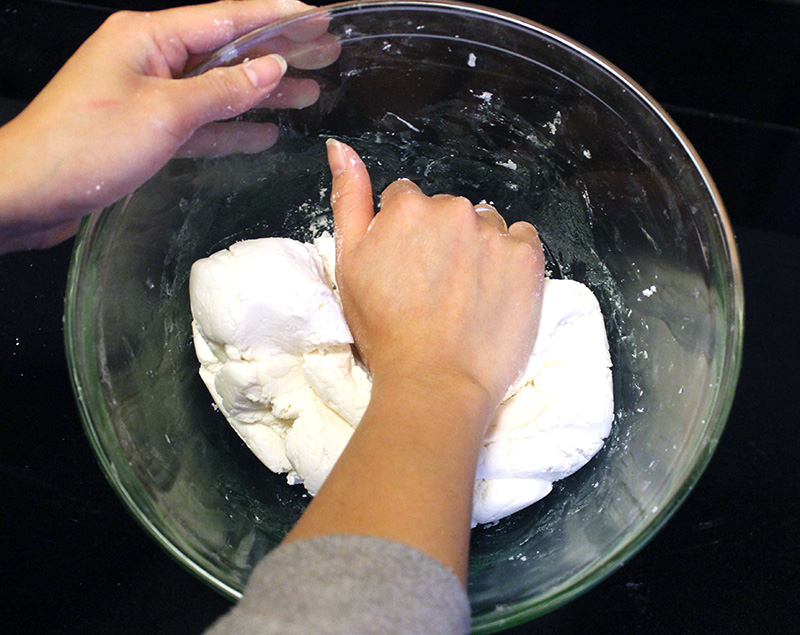
Your dough should be ready when it feels moist but does not stick to your fingers. Make sure that it can stretch smoothly and easily without breaking. If you do not knead enough, your bánh giầy will not be chewy the way it should be. If you knead your dough too much, your bánh giầy will be unappetizingly rubbery and elastic.

Once you have achieved the correct texture for your dough, then cover it and set aside to rest at room temperature for approximately 30 minutes.
In the meantime, defrost, clean, and dry the banana leaves. Cut into squares approximately 8cm x 8cm. Brush a small amount of vegetable oil onto the outside of the leaf, which is dark green and shiny. This will be the side that contacts the bánh giầy.
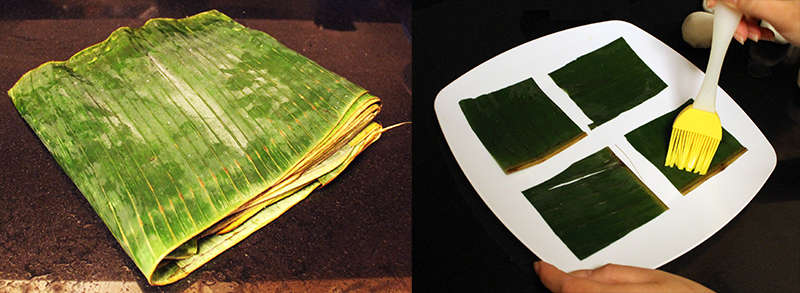
Divide your dough into 16 portions. Roll each portion into a ball and place onto a square of banana leaf. Flatten into a disc, approximately 1cm in thickness.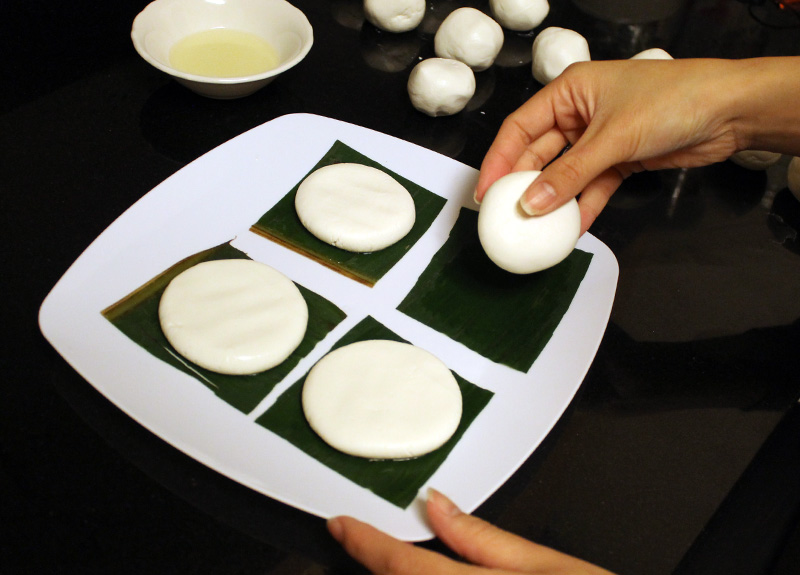
Prepare your steamer. I use a steamer set given to me by my mom (Mẹ). The bottom layer contains boiling water; the middle 1-2 layer(s) are perforated for steaming; and, of course, the top is a lid. Any steamer will do – even many rice cookers can double as a steamer!
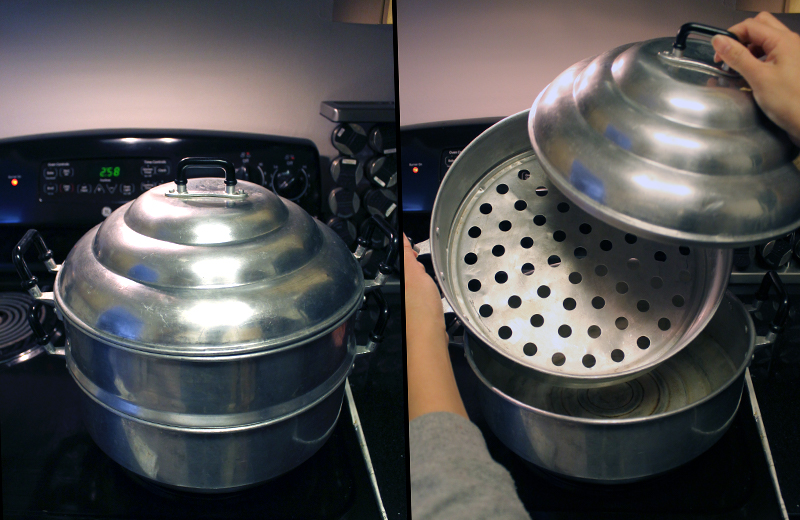
Arrange the bánh giầy with a little room between them. They do spread but just a tiny bit.
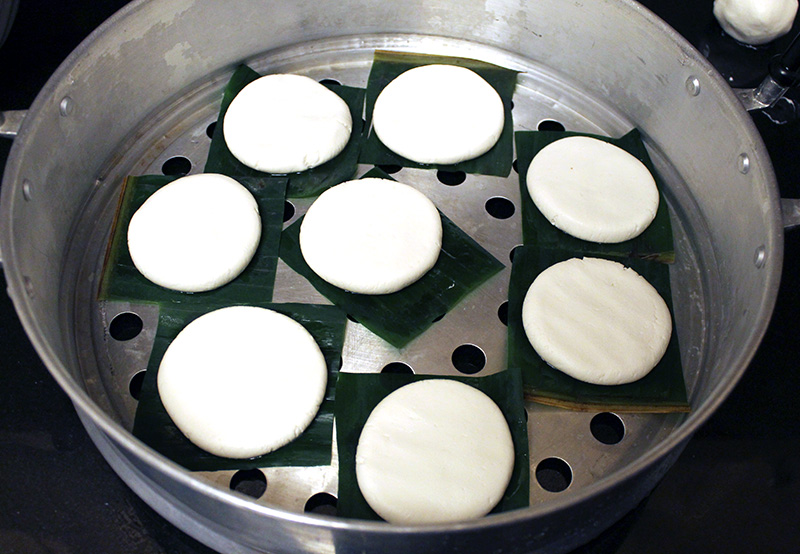
Place a towel over the steamer then close the lid. This is to prevent condensation dripping onto the bánh giầy. Take precautions to wrap the towel around the lid or tie it upwards to prevent contact with the burner; otherwise, this could be a fire hazard.
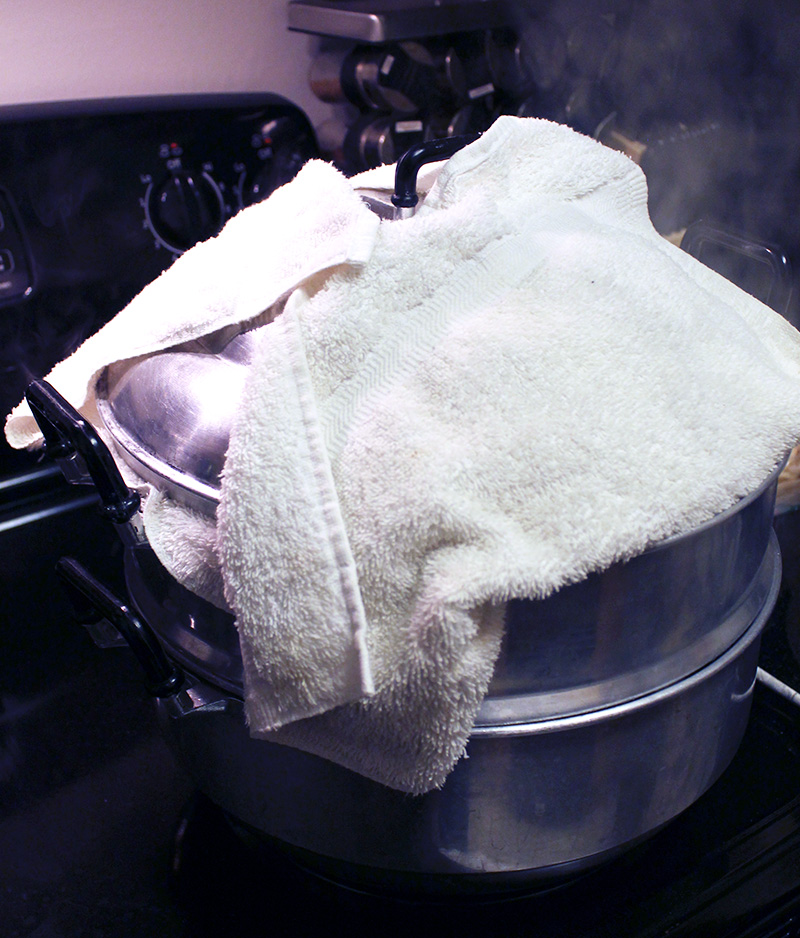
Steam for 3 minutes; remove the lid to release steam. Repeat for 3 more minutes; remove the lid again. Then repeat for the final 3 minutes. The total cooking time is 9-10 minutes. The opacity of the bánh giầy will change from a solid bright white to a slightly translucent but still opaque cream-white color.
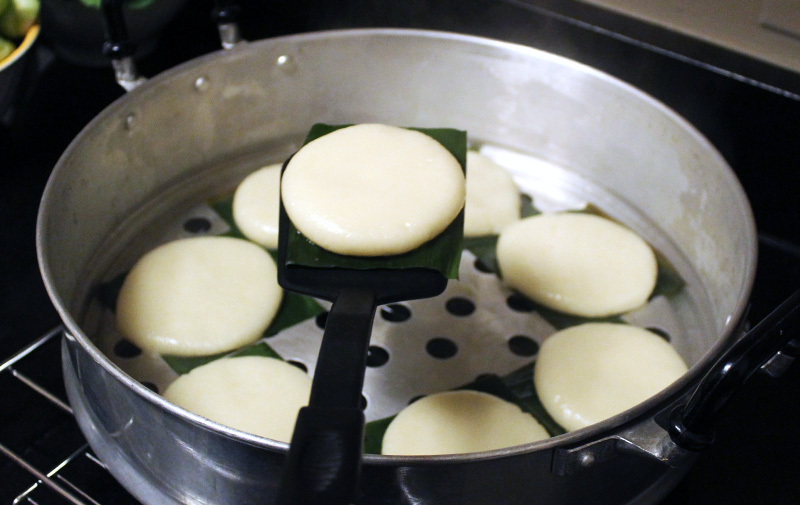
Transfer the bánh giầy onto a drying rack to cool.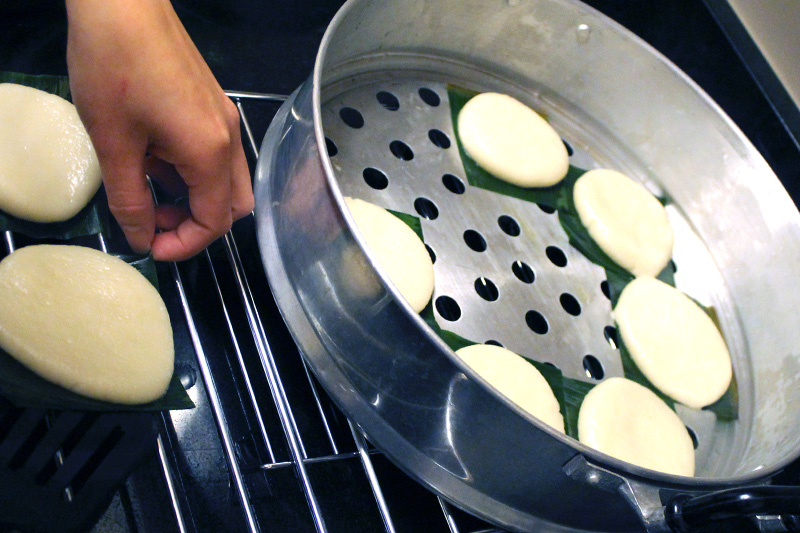
That’s it – you’re done! Your bánh giầy should be beautifully round, nicely chewy, with the very slightest hint of salt, and a hint of banana leaf (different essence than banana fruit itself). Deliciously simple.
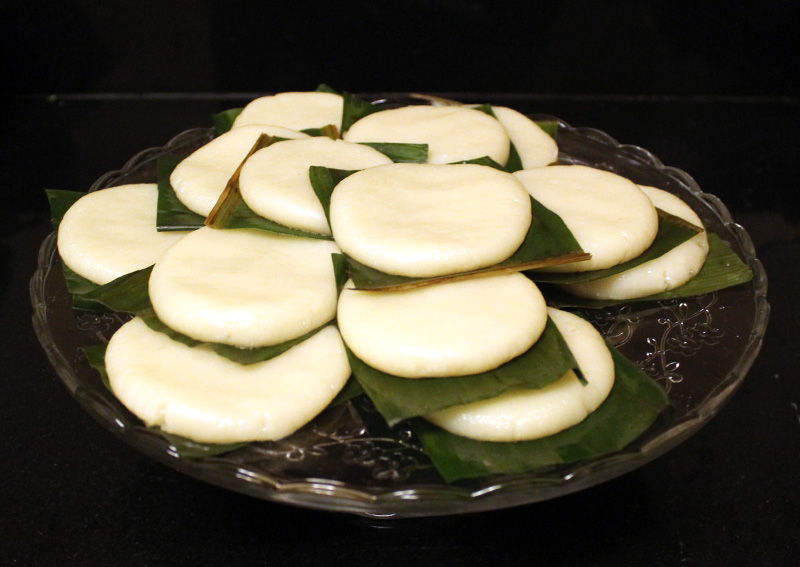
By the way, for our Lunar New Year party, we did not make our own giò lựa. Instead we bought giò huế (a variation of giò), which is sole pre-steamed. We sliced it to go into our bánh giầy sandwich. A blog post on how to make giò will be a future post…
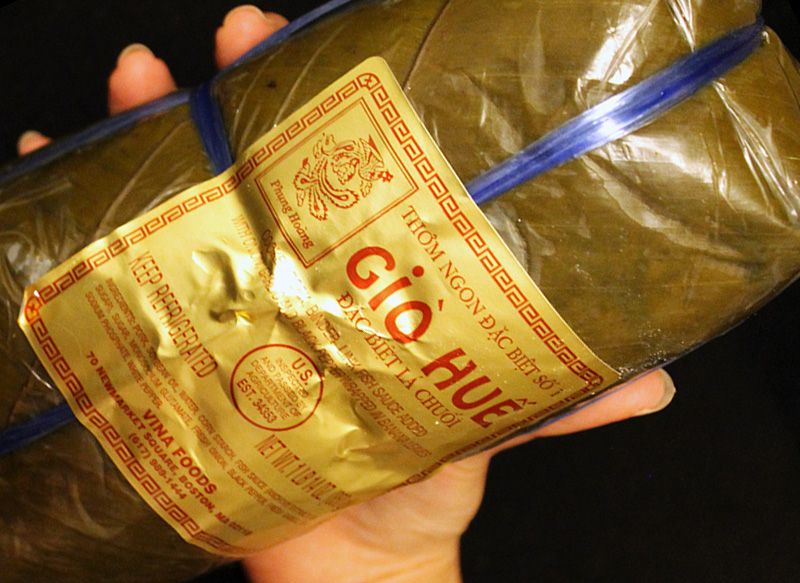 Leave the banana leaf on the bánh giầy as you assemble your bánh giầy kẹp giò (bánh giầy and giò sandwich). The leaf will also serve to keep your bánh giầy moist and prevent your fingers from getting sticky when you handle the bánh giầy! Peel the leaf off sections at a time as you munch.
Leave the banana leaf on the bánh giầy as you assemble your bánh giầy kẹp giò (bánh giầy and giò sandwich). The leaf will also serve to keep your bánh giầy moist and prevent your fingers from getting sticky when you handle the bánh giầy! Peel the leaf off sections at a time as you munch.

Here’s half of our edible spread from our Lunar New Year party. Thanks to our fantastic friends – Jenny, Evan, Caroline, Jackie, Peter – who generously helped us consume our feast and welcome in the new year. Thanks to you for learning about bánh giầy! We would love to see and hear about how your bánh turn out in the Comments section below. Also, please share your tips and tricks, ideas to improve our recipe by sharing in the Comments section below!
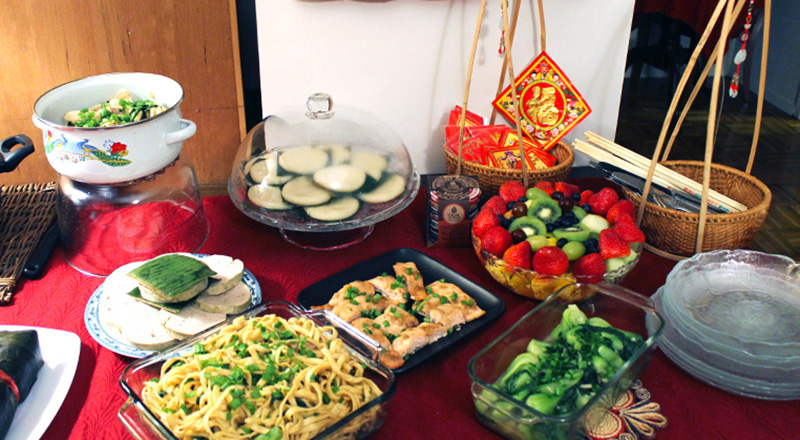 Happy Lunar New Year!
Happy Lunar New Year!
Chức mừng năm mới!
新年快樂!
Until next time,
Kathy May and Silas
Perhaps we have unknowingly consumed them before, but we’ve certainly never heard of ramps. What we’ve learned about them is fascinating! They’re scarce because they grow exceedingly slowly (four years!) and are only in-season a few weeks of the year. In recent years, they’re all the craze among foodies and chefs: “The Church of the Ramp is one of the fastest-growing denominations in the religion of seasonality.” Due to a combination of the plant’s rarity and the explosion of enthusiasm for it, wild ramps are wantonly overharvested. In Quebec, there are firm restrictions on commercial sales and harvesting more than personal consumption, giving rise to an active black market for the coveted wild ramps. Smugglers bring bulbs to neighboring provinces including Ontario, where sales are legal… and they make a cushy profit. If you’re interested in learning more about the role of ramps in the food universe, here are a couple of amusingly written reflections on ramps from Huffington Post and TIME Magazine.
The other vegetable in our food box with which we’re less familiar is radicchio. Radicchios aren’t lettuce or cabbage. They come from northern Italy and the varieties are named after towns within the Veneto region. We Americans are most familiar with Rosso di Verona radicchio while Italians most commonly eat Treviso radicchio. Now – late winter – is exactly when radicchios peak.
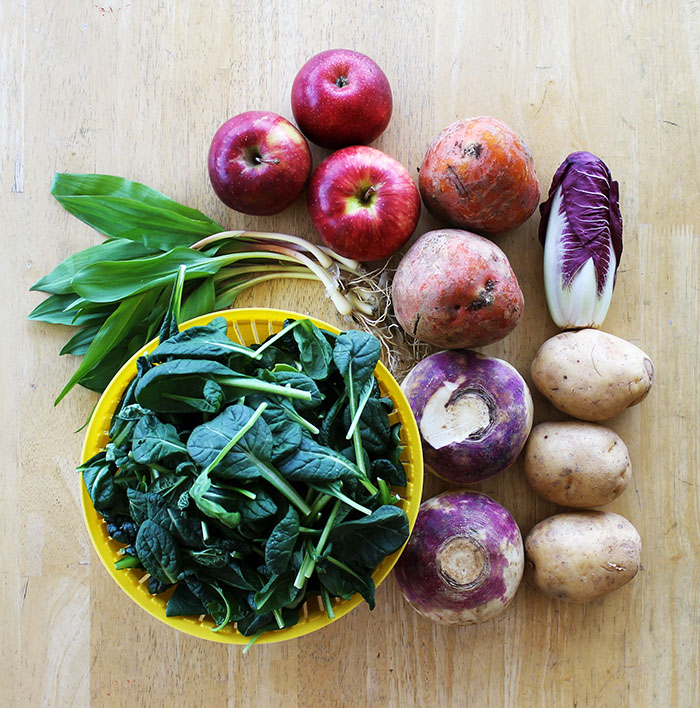
Looking back, our first experiences with a CSA has been quite a fun and delicious culinary adventure! It’s provided us with months of experimentation, learning, and full stomachs for us and our friends! Each week we’ve had the pleasure of produce that is fresh from the farm; we’ve tasted foods we’ve never purchased or even encountered; and we’ve discovered new recipes along the way. Even beyond the kitchen, we support the overall concept of community-supported agriculture and the economically and environmentally sustainability that it facilitates. There is an obvious relationship between farmer and consumer with the sale of any kind of produce, but CSAs make that relationship more of a partnership that benefits both parties. Hopefully CSA models will become more common and more available – because it works!
By the way, if you are familiar with any CSAs in the Boston area (that are reliable and have flexible terms) please let us know!
Until next time,
Kathy May and Silas
While the intent of our CSA is to provide seasonal produce from local farms within a 300 mile radius, the winter months require a little stretching of the rule – that is why we have had apples for many weeks in a row. Apples are easily pulled from storage in months when farmed fruits are scarce. We’ve had no repeats in varieties, however, and this week we have Empire apples! Empire apples are named for our great state of New York. They were developed right here by a Cornell University nutritionist in the 1940s and are a cross between McIntosh and Red Delicious apples. The Empire apples in our box came from Upstate New York.
FYI, in case you’re wondering… a cremini/crimini mushroom is actually just a baby portobello mushroom that is immature with a brown cap. We were hugely surprised to learn that an even earlier stage of maturation, before the cap develops a darker flesh, it is called a button mushroom!
Until next time!
– Kathy May and Silas
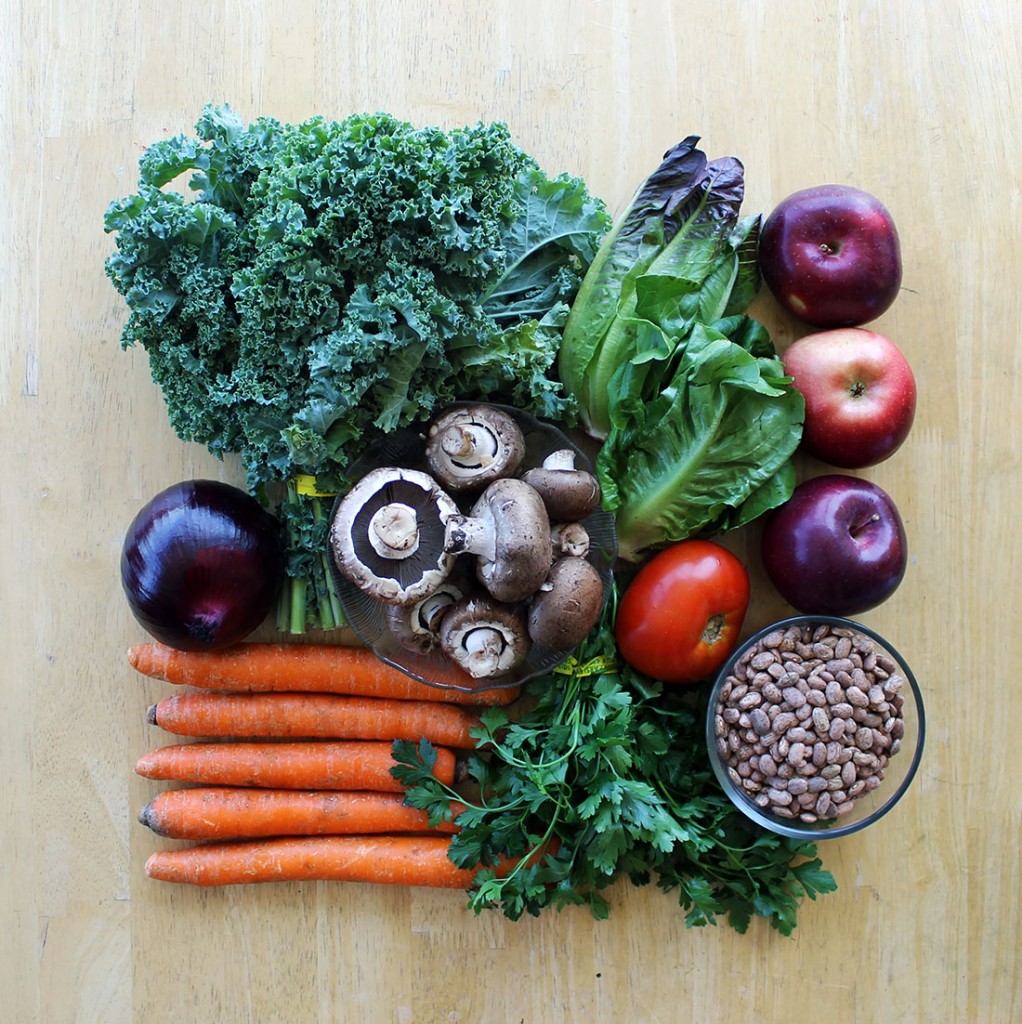
]]>
Fun facts for this week’s CSA box:
- That is not ginger you see in our photo! Sunchokes are yet another food that we’ve never encountered (why we love our CSA). Believe it or not, sunchokes are the tubers of a plant related to the sunflower! Even though they’re also known as Jerusalem artichokes, they have no relation to the city (actually, they’re native to North America) nor are they a variety of artichoke (though they are related via the daisy).
- It is not surprising why Lacinato kale is also known as dinosaur kale. As you can see, the texture of its leaves creates a pattern reminiscent of how we think the skin of ancient monsters may have looked.
- So far, we have had a number of apple varieties come through our CSA – Cameo, Mutsu (Crispin), Pink Lady, Fuji, Gala, etc. The Jonagold apple in this week’s box is a cross between Golden Delicious and the heritage Jonathan apple. The variety was developed fairly recently in the 1950s at Cornell University.
We’re off to enjoy our culinary excitement for the week!
– Kathy May and Silas
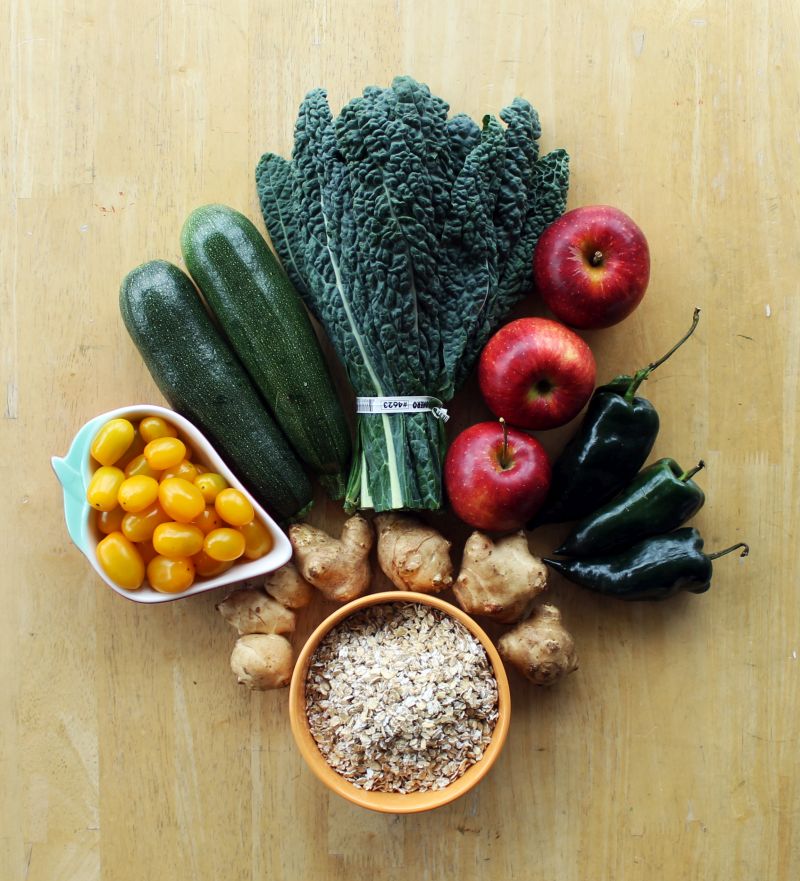
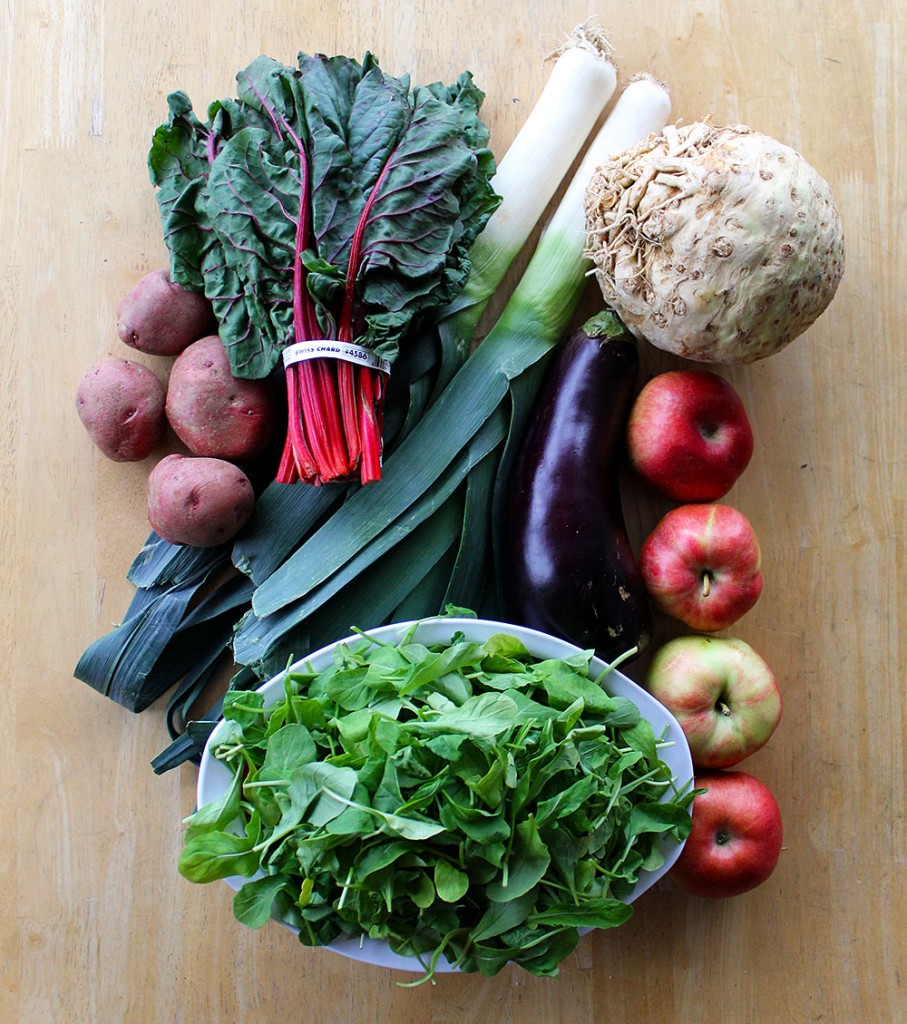
We trimmed off the greens and the root, and sliced them in half lengthwise. Then we heated butter in a pan and added the radishes when the butter started to foam.
[See image gallery at www.kathymayandsilas.com]We added salt and pepper, and sautéed them until they started to brown and become translucent.
[See image gallery at www.kathymayandsilas.com]They tasted quite good with butter and had a very mild flavor. Too bad we didn’t have more! Leave us a comment if you’ve tried it or if you have a favorite recipe!
Enjoy,
Silas and Kathy May
]]>
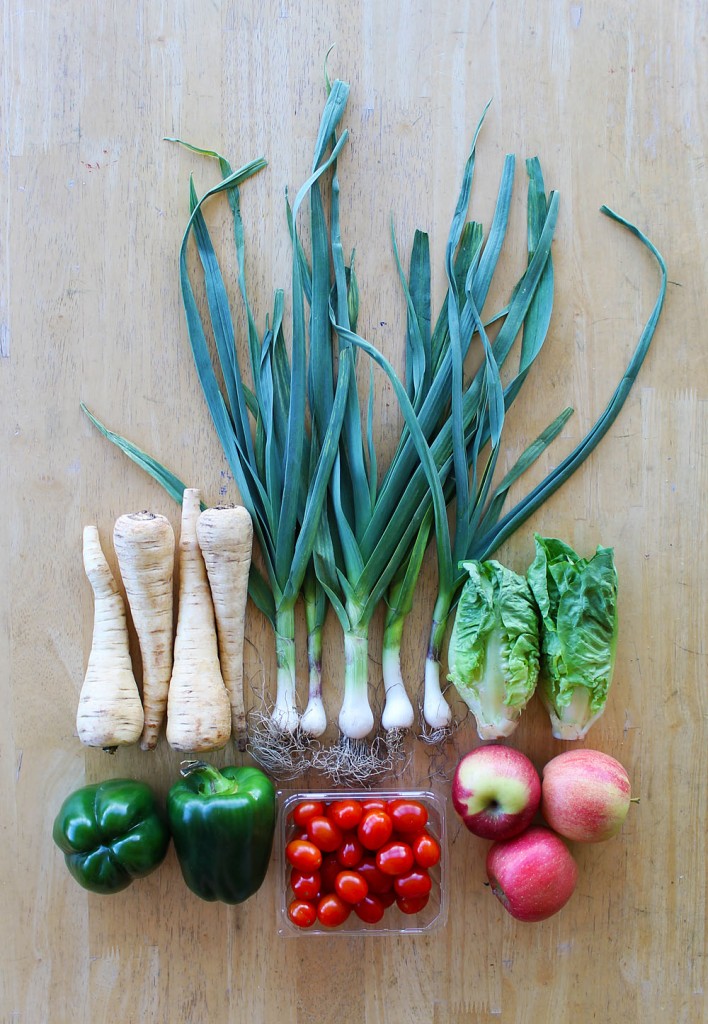
Yum!
– Silas and Kathy May
After looking online for recipes, we decided to keep it simple: roast the florets and sauté the greens and stems. The head cuts apart very easily by cutting the florets from the stem from the bottom up.
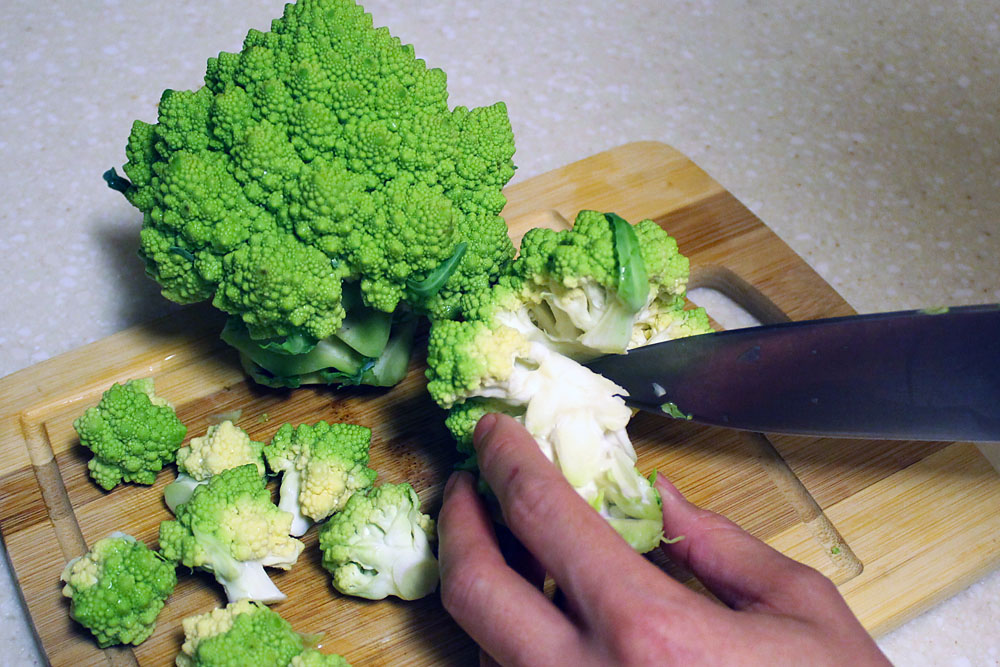
We tossed the florets in olive oil and Cajun seasoning (Tony Chachere’s) and then roasted them at 400°F for 20 minutes.
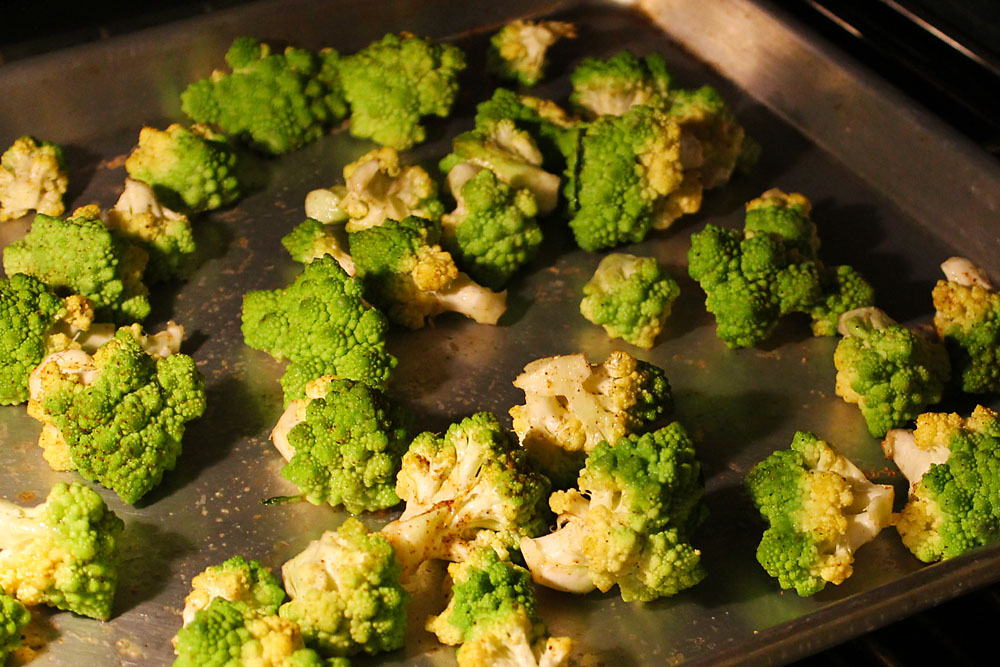
We sautéed the greens and stems in olive oil and garlic with salt and pepper, adding a small amount of water and covering for about 5 minutes to steam them.
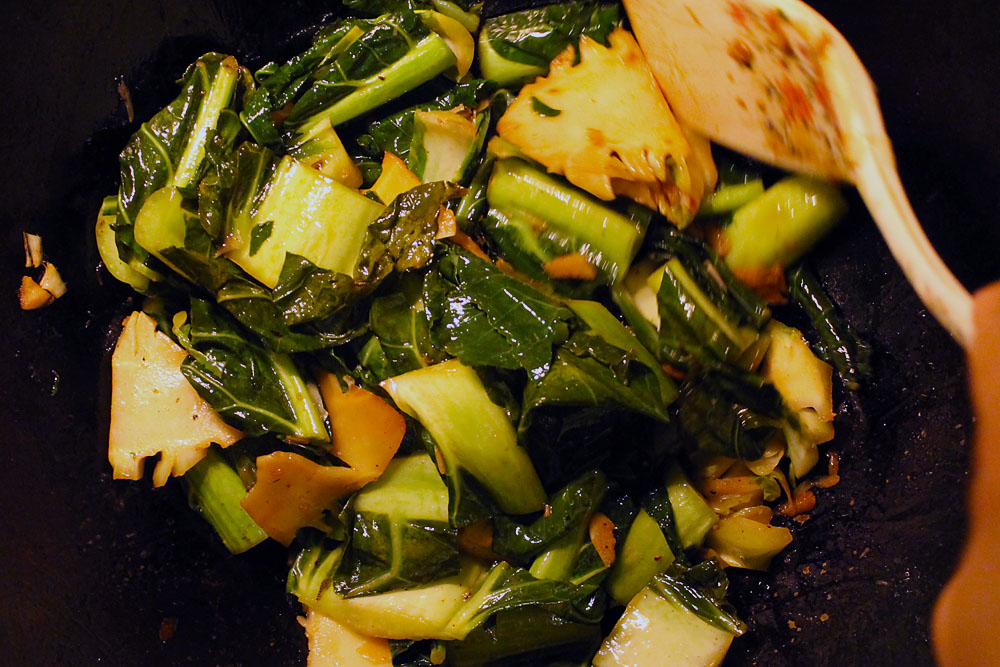
Here are the final results! The Romanesco is crunchy and looks like broccoli but tastes more similar to cauliflower and has a bit of a nutty flavor. The greens seem similar to other kinds of greens that we’ve had such as turnip greens.
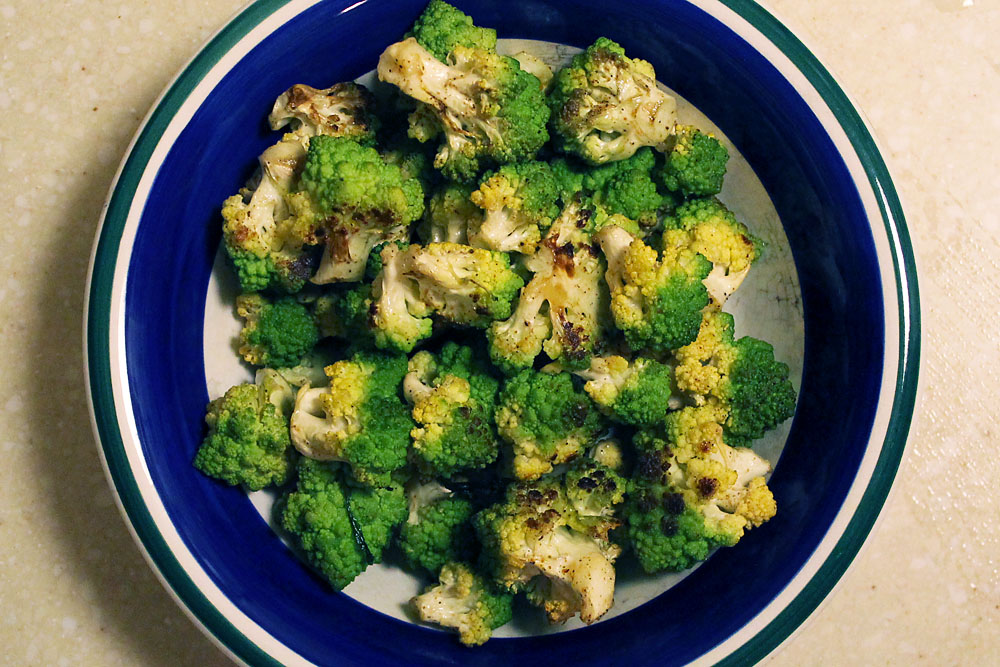
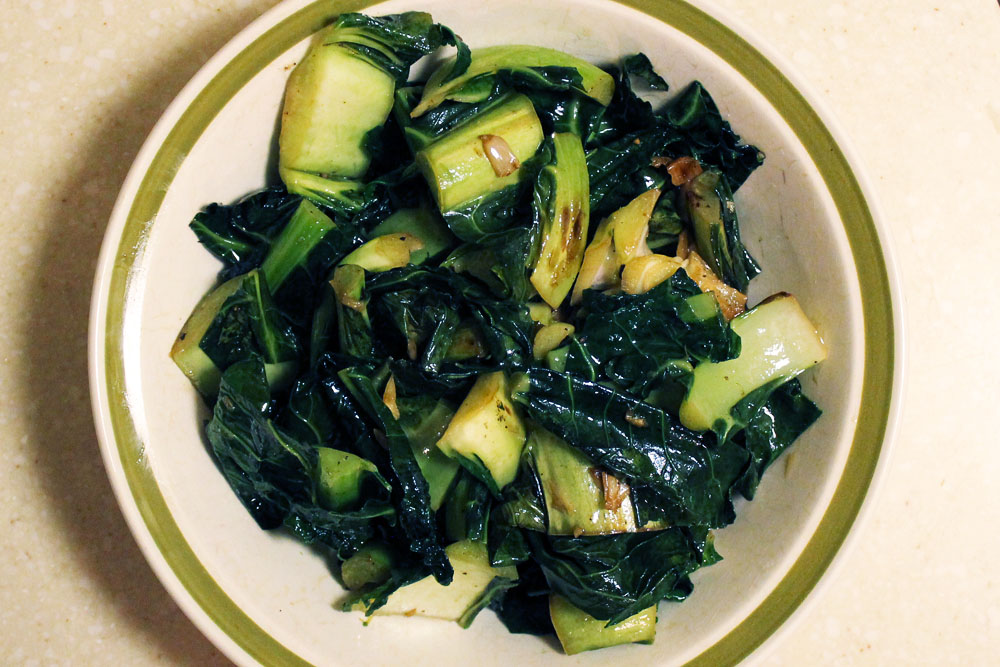
We had a great first experience with Romanesco! Leave us a comment if you’ve tried it or if you have a favorite recipe!
Enjoy,
Silas and Kathy May